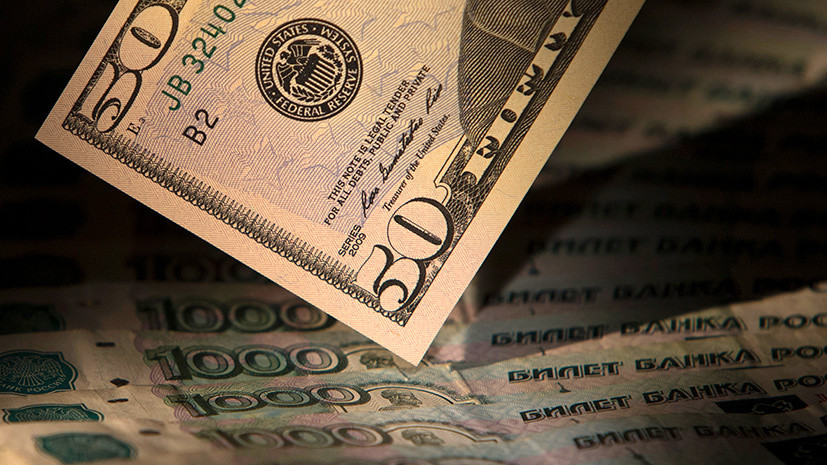On Thursday, December 12, trading on the Moscow Exchange is accompanied by a record strengthening of the Russian currency. Thus, the dollar depreciated by 0.8% and for the first time since July 19 reached 62.7 rubles. The euro exchange rate fell 1% and reached 69.7 rubles. The last time a similar value could be observed on March 12, 2018.
The official exchange rate of the Central Bank on December 13 was 63.23 rubles per dollar and 70.43 rubles per euro.
To a certain extent, the Russian currency was supported by a marked increase in world oil prices. During trading on the ICE exchange in London, the raw materials of the Brent benchmark rose immediately by 1.6% to $ 64.7 per barrel. The main reason for the rise in oil prices in recent days has been the decision of the OPEC + countries to further reduce hydrocarbon production. This was told to RT by the head of the analytical research department of the Higher School of Financial Management Mikhail Kogan.
“The recent OPEC + decision while maintaining generally favorable conditions on world markets in the near future will only strengthen the ruble,” the expert believes.
However, the influence of commodity quotes on the ruble is limited by the budget rule, which stipulates that during the rise in oil prices the Ministry of Finance buys foreign currency and thereby puts pressure on the ruble. Moreover, in the event of a collapse in the energy market, the ministry ceases operations - and pressure on the ruble weakens. As a result of such actions, the dependence of the national currency on oil prices is reduced.
Recently, the effect of the fiscal rule has already weakened the relationship between the ruble and oil, but currency market players still sometimes react to sharp changes in commodity prices.
“Although the budget rule weakens the influence of oil prices through the current account of the balance of payments, high quotes reduce the risks of investing in Russia and maintain the flow of capital,” Mikhail Kogan explained.
In addition, the analysts polled by RT analysts attribute the observed strengthening of the Russian currency to the American one with a noticeable weakening of the dollar in the world market. The corresponding DXY index dipped 0.3% and for the first time since the beginning of November dropped to 97 points. Such data are provided by the international exchange ICE.
The American currency began to weaken sharply after the next meeting of the top management of the Central Bank of the United States. On the eve of the US Federal Reserve Open Market Committee, the interest rate remained unchanged after three consecutive cuts. In addition, the Fed is planning to no longer cut rates until 2023. This is stated in the materials of the regulator.
Thus, in the near future, the interest rate in the United States will remain at the minimum level over the past year and a half - 1.5-1.75% per annum. As a result, global investors will begin to invest in more risky securities and currencies of countries where rates are still high.
“Under the circumstances, the appetite for buying risk is growing, while the dollar is weakening against other currencies. Against this background, oil quotes are also rising to the level of $ 64 per barrel, and the ruble exchange rate manages to strengthen, ”said Anton Pokatovich, chief analyst at BCS Premier, to RT.
Trade expectation
According to Anton Pokatovich, in the near future, the attention of foreign exchange market investors will be focused on the development of trade relations between the United States and China.
In October, Washington and Beijing again intensified negotiations to conclude a trade agreement and end the tariff war. In November, US President Donald Trump announced the possibility of signing the first part of the agreement in the near future. Meanwhile, the American president threatened China with a new increase in duties in the event of another failure of the transaction. As expected, restrictions may be introduced as early as December 15th.
Traditionally, during the growth of geopolitical tensions in the world, investors begin to sell risky assets. As Pokatovich noted, such a development of events may put some pressure on the Russian currency.
“The main risks to the assets of emerging markets are still concentrated in the trading plane. However, it is not yet clear whether the US will go for the introduction of new tariffs for goods from China or not, ”the analyst said.
As Andrei Lyushin, deputy chairman of the board of CB LOCO-Bank, said in an interview with RT, in the coming days, the Bank of Russia will be able to support the Russian currency. On December 13, following the results of the last meeting in 2019, the Board of Directors of the Central Bank can reduce the interest rate for the fifth consecutive time and bring it to the level of 6.25% per annum. The value is expected to be the lowest since March 2014.
The observed decrease in the Central Bank rate over time will make investments in federal loan bonds (OFZ) less profitable, so market players are trying to pre-purchase securities at a bargain price. According to analysts, the booming influx of money in OFZ plays in favor of strengthening the ruble.
However, according to Anton Pokatovich’s assessment, the outcome of trade disputes between the United States and China will be the determining factor for the national currency to the end.
“According to our estimates, if the United States refuses to impose new trade restrictions on China, the dollar will end the year in the range of 62.5–63.8 rubles, and the euro - 70–71.6 rubles. If the trade war continues, market optimism will weaken somewhat, and under these conditions, the dollar exchange rate will reach 63.5–65 rubles by the end of the year, and the euro exchange rate will be 71–72.5 rubles, ”the expert concluded.

